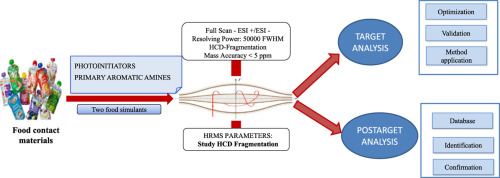Talanta ( IF 5.6 ) Pub Date : 2018-08-18 , DOI: 10.1016/j.talanta.2018.08.047 Yovana Sanchis , Clara Coscollà , Vicent Yusà

|
A comprehensive strategy for the analysis of UV-ink photoinitiators and primary aromatic amines (PAAS) in food-packaging materials such as, juice tetrabricks, pouches and bags has been developed using liquid chromatography coupled to Orbitrap High-Resolution Mass Spectrometry (LC-Orbitrap-HRMS). The methodology includes both quantitative target analysis and post-run target screening analysis. The quantitative method was validated after a previous optimisation of the single-stage Orbitrap fragmentation through the Higher-Energy Collisional Dissociation (HCD) Cell. Overall, the quantitative method presented recoveries ranging from 78% to 119%, with a precision (RSD) lower than 20%, for the 18 substances in the scope of the target method. Limit of quantification (LOQ) for UV-inks photoinitiators ranged from 0.5 µg/kg−1 for Isopropyl Thioxanthone (ITX) and 2-Ethylhexyl 4-(dimethylamino) benzoate (EHDAB) to 5 µg/kg−1 for the rest of photoinitiators. LOQ for PAAs were 2 µg/kg−1 except for aniline (ANL) and 3,3′ dimethylbenzidine (3,3′-DMB) which was 2.5 µg/kg−1 in the two studied simulants (acetic acid 3% and ethanol 50%). For post-run target screening a customized theoretical database, that included Bisphenols, Polyfluorinated compounds (PFCs), Phosphorus Flame Retardants (PFRs) and other substances was built. For identification purposes, a mass accuracy lower than 5 ppm, and some diagnostic ions including isotopes and/or fragments were used.
The strategy was applied to 18 samples collected in the Valencian region (Spain). No compounds were detected when the standardised migration test was applied. However, in the destructive test, benzophenone and EHDAB were determined from tetrabrick and pouch materials. In the post-run target analysis two PFCs (Perfluorooctanoic acid and Perfluoro-1-butanesulfonate) and four PFRs (2-ethylhexyl diphenyl phosphate, tris(2-choloroisopropyl) phosphate, triphenyl phosphate and 2-ethylhexyl diphenyl phosphate) were identified.
中文翻译:

液相色谱法对食品接触材料中的光引发剂和芳族伯胺进行综合分析
使用液相色谱与Orbitrap高分辨率质谱法(LC-Orbitrap)结合,已开发出一种用于分析食品包装材料(例如果汁四砖,袋和袋子)中的UV墨水光引发剂和伯芳香胺(PAAS)的综合策略。 -HRMS)。该方法包括定量目标分析和运行后目标筛选分析。先前通过优化高能碰撞分离(HCD)细胞对单阶段Orbitrap片段进行优化后,对定量方法进行了验证。总体而言,该定量方法对目标方法范围内的18种物质的回收率在78%至119%之间,而精密度(RSD)低于20%。紫外线油墨光引发剂的定量限(LOQ)为0.5 µg / kg -1对于其余的光引发剂,异丙基噻吨酮(ITX)和4-(二甲基氨基)苯甲酸2-乙基己酯(EHDAB)的浓度为5 µg / kg -1。PAA的LOQ为2 µg / kg -1,除了苯胺(ANL)和3,3'二甲基联苯胺(3,3'-DMB)在两种研究的模拟物中(乙酸3%和乙醇)为2.5 µg / kg -1 50%)。为了进行运行后目标筛选,建立了一个定制的理论数据库,其中包括双酚,多氟化合物(PFC),磷阻燃剂(PFR)和其他物质。为了进行鉴定,质量精度低于5 ppm,并且使用了某些诊断离子,包括同位素和/或碎片。
该策略适用于在巴伦西亚地区(西班牙)收集的18个样本。应用标准化迁移测试时未检测到任何化合物。然而,在破坏性测试中,由四砖和袋材料确定了二苯甲酮和EHDAB。在运行后目标分析中,确定了两个PFC(全氟辛酸和全氟-1-丁磺酸)和四个PFR(2-乙基己基磷酸二苯酯,磷酸三(2-氯异丙基)酯,磷酸三苯酯和2-乙基己基磷酸二苯酯)。











































 京公网安备 11010802027423号
京公网安备 11010802027423号